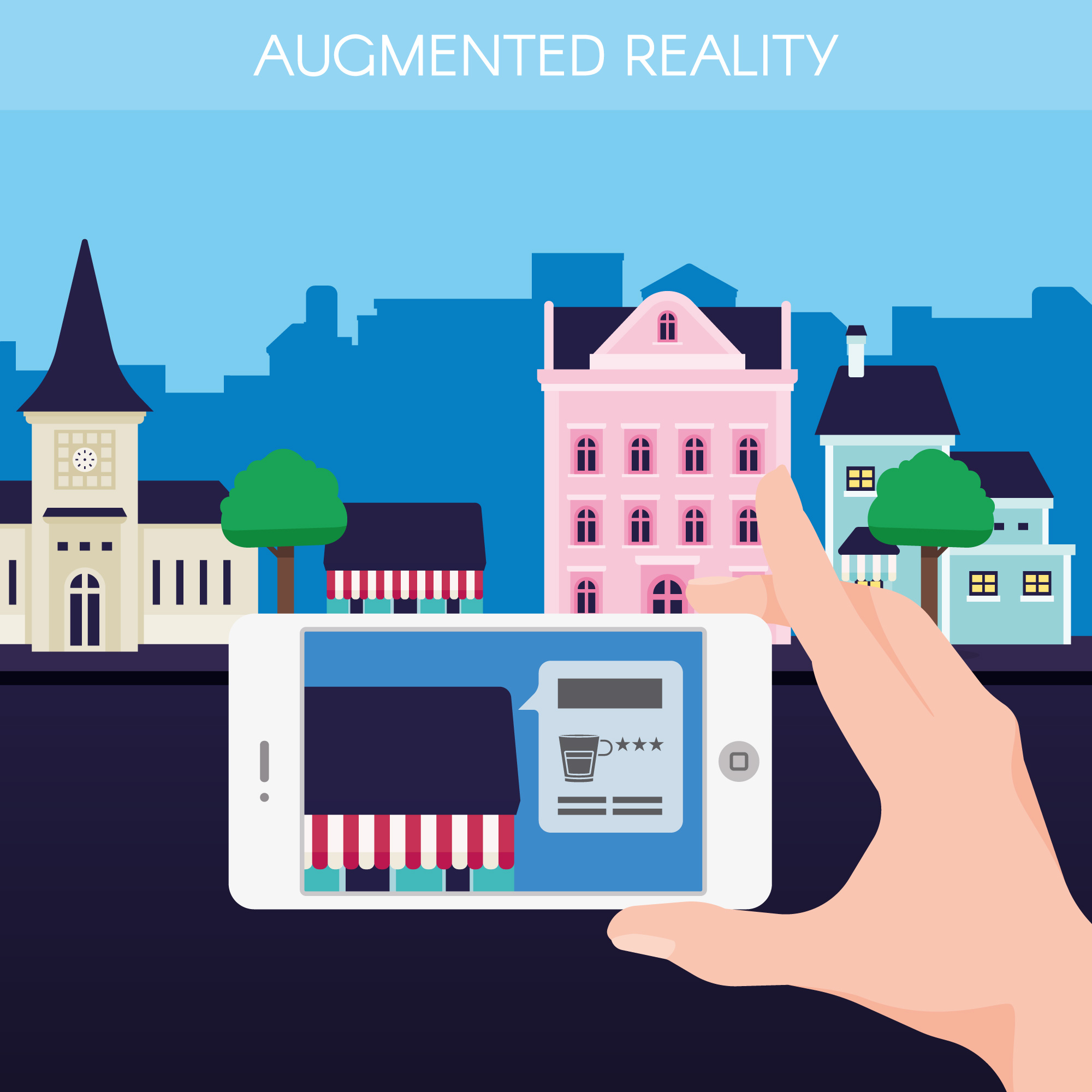
Future of Augmented Reality
 Augmented reality, or AR, is a piece of technology that lets you experience the real-world environment with computer-generated objects. AR overlays the computer-generated objects over the real-world object and alters how we perceive the world around us, unlike Virtual Reality which replaces our reality with a computer generated one[1].The idea for AR glasses came from the author of the Wizard of Oz, L. Frank Baum, in 1901. He came up with the idea for glasses that you could put up and see a letter on the forehead of people you meet. The letter would indicate what kind of character the persons was so you could determine the true natures of all you come across [2]. AR did not really become popular until the smartphone came on the market. We see AR almost every day and it’s getting more and more popular every day. For example, when you use Snapchat and apply a filter, that’s Augmented Reality. However, the question remains, where is AR heading in the future?
Augmented reality, or AR, is a piece of technology that lets you experience the real-world environment with computer-generated objects. AR overlays the computer-generated objects over the real-world object and alters how we perceive the world around us, unlike Virtual Reality which replaces our reality with a computer generated one[1].The idea for AR glasses came from the author of the Wizard of Oz, L. Frank Baum, in 1901. He came up with the idea for glasses that you could put up and see a letter on the forehead of people you meet. The letter would indicate what kind of character the persons was so you could determine the true natures of all you come across [2]. AR did not really become popular until the smartphone came on the market. We see AR almost every day and it’s getting more and more popular every day. For example, when you use Snapchat and apply a filter, that’s Augmented Reality. However, the question remains, where is AR heading in the future?
AR today
Not long-ago Apple gave out its newest operating system, iOS 11. With that came the AppleAR kit that allowed iPhone users to use AR on their phones. Ikea gave out an app called Ikea Place, which allows users to view and place Ikea furniture anywhere they like. Let us say you found a great table to put up in your living room, but you don’t know how it would look? Don’t worry, you can use Ikea’s app to place the table in the living room in 3D and see how it would look [3]. This is a rising phenomenon with Amazon developing a similar app.
Companies are trying to test the functionality of AR with shopping and everyday things. Imagine going out for groceries and you could make a shopping list on the stores app. You would walk in, pick up your phone and turn on the camera. On the screen, the floor would light your way to the products you’re going to buy. After you pick up your item, the camera would scan the barcode and ask if you would like to add this item to your cart. After you are done, you would go to the register and you could scan you phone to add all your items to the register, all with one scan [2].
Where is AR heading in the future? Can AR help us with work or even our daily lives?
The people over at DAQRI, a leader in Professional Grade AR, are working on a product to help companies see their ideas in the real world before making them. Daqri is working on two major products, Work sense and DAQRI Smart Glasses. These products link digital content to the real world to accelerate productivity [4]. With this technology we would be able to see, for example the building that is supposed to be built before it is even built, walk around and see the walls, lighting, furniture, you name it. We could be working on a road construction and see where all the pipes are and prevent the mistake of breaking them. These headsets would set you back about 5000$ if you were buying them for yourself.
Microsoft is also working on their own AR glasses called Microsoft HoloLens. These classes are a mix of AR and VR, called mixed-reality. The glasses project a hologram that can appear as part of your surroundings or combine with reality and make up new ones. This isn’t like the holograms in the sci-fi films, but instead a hologram that appears in the glasses. You can share your holograms with others if they have the headset and they can see what you see [5].
This could be used for education or medicine. Imagine studying medicine and you were told to put up you AR glasses. Suddenly you can see the human anatomy, standing on the floor in the classroom. The teacher could interact with the hologram and show you all the organs and bones. Since 2005 there has been a device that can project a frame on your body and see the outlines of your veins. It’s called near-infrared vein finder. This has helped doctors and nurses to find veins with ease [1]. With Microsoft HoloLens, doctors could see the patient’s vital signs in his goggles.
Elon Musk, founder of PayPal and Tesla Motors, is trying to make a computer chip that would be implemented in your skull and make your brain function like a computer. It’s called Neura link and was initially made for people with degenerative brain diseases like Alzheimer. This would give them access to more memory but later this device could be used by everyone. Imagine, typing with your brain, learning to cook just like Neo in the Matrix learned Kung Fu, or even better, share memories with others with AR, without using AR glasses [6]. This is Elon Musk’s way of preparing humanity to be one step ahead ofA I in the future. For manufactures to be able to put adds in magazines or newspapers that could be viewed with AR. Seeing an add for a car, you pick up your phone and turn on you AR kit and you can see that car pop up on your table to be viewed in 3D.
Things like this can be possible in the near future with AR being developed at a fast rate [2]. No one can really say for certain what AR will look like in the future but with everything that is going on right now and what is in the works, we can safely assume that the future of AR will be spectacular.
Author: Gautur Arnar Guðjónsson, student at Reykjavik University
References
[1]“Augmented reality,” Wikipedia. 10. Sep., 2018 [Online]. Available: https://en.wikipedia.org/w/index.php?title=Augmented_reality&oldid=858888973. Accessed: 17. Sep., 2018.
[2]“The future of augmented reality.” [Online]. Available: https://www.cnbc.com/video/2018/05/29/the-future-of-augmented-reality.html. Accessed: 17. Sep., 2018.
[3]D. Lee, “Ikea Place is an AR app that lets you put furniture on the street,” The Verge, 20. Sep., 2017. [Online]. Available: https://www.theverge.com/2017/9/20/16339006/apple-ios-11-arkit-ikea-place-ar-app. Accessed: 17. Sep., 2018.
[4]“DAQRI -About.” [Online]. Available: https://daqri.com/about/. Accessed: 17. Sep., 2018.
[5]“Microsoft HoloLens: Everything you need to know about the $3,000 AR headset,” Wareable. [Online]. Available: https://www.wareable.com/ar/microsoft-hololens-everything-you-need-to-know-about-the-futuristic-ar-headset-735. Accessed: 2. Apr., 2018.
[6]T. Darling, “Big AR: The Future of Augmented Reality,” Hacker Noon, 9. Aug., 2017. [Online]. Available: https://hackernoon.com/big-ar-the-future-of-augmented-reality-c91c267b3d9f. Accessed: 17. Sep., 2018.
Image: Designed by Freepik
Skil á efni
Leita í vefútgáfu Tölvumála
Um Tölvumál
Tölvumál - tímarit Skýrslutæknifélags Íslands er óháð tímarit um tölvutækni og hefur verið gefið út frá árinu 1976.
Vefútgáfa Tölvumála birtir vikulega nýja grein á vef Ský og árlega er gefið út veglegt prentað tímarit undir nafninu "Tölvumál" þar sem fjallað er um tölvutækni frá ýmsum sjónarhornum og er þema blaðsins jafnan valið snemma árs og útgáfa að hausti.
Ritnefnd Ský sér um að afla efni í Tölvumál og geta allir sem áhuga hafa sent inn efni.
